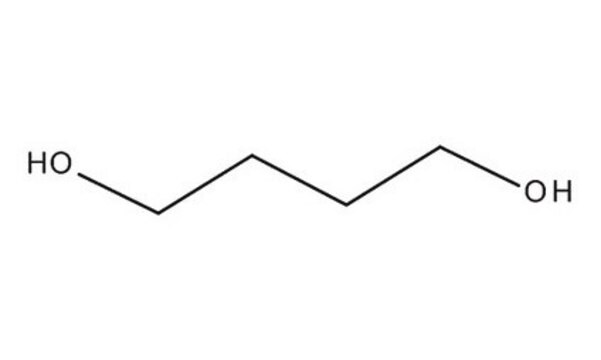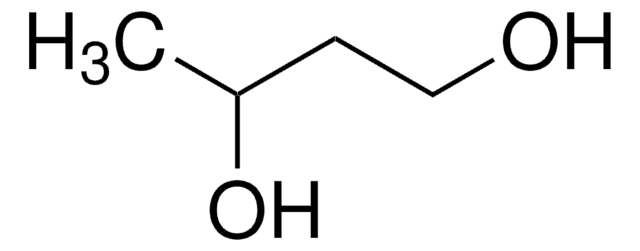493732
1,4-Butanediol
ReagentPlus®, 99%
Sinónimos:
1,4-Butylene glycol, Tetramethylene glycol
About This Item
Productos recomendados
densidad de vapor
3.1 (vs air)
Nivel de calidad
Línea del producto
ReagentPlus®
Análisis
99%
formulario
solid or viscous liquid
temp. de autoignición
698 °F
índice de refracción
n20/D 1.445 (lit.)
bp
230 °C (lit.)
mp
16 °C (lit.)
densidad
1.017 g/mL at 25 °C (lit.)
cadena SMILES
OCCCCO
InChI
1S/C4H10O2/c5-3-1-2-4-6/h5-6H,1-4H2
Clave InChI
WERYXYBDKMZEQL-UHFFFAOYSA-N
¿Está buscando productos similares? Visita Guía de comparación de productos
Categorías relacionadas
Aplicación
- Homoallyl alcohol (3-buten-1-ol) and tetrahydrofuran via vapor-phase dehydration using ZrO2 as a catalyst.
- Poly(1,4-butanediol succinate) polymer by reacting with succinic anhydride.
- Biodegradable homopolyesters [poly(butylene succinate) and poly(butylene adipate)] and copolyesters [poly(butylene succinate-co-butylene adipate)] by treating with succinic acid and adipic acid via esterification and deglycolization reaction.
- Poly(1,4-butyl sebacate) by polyesterification reaction with sebacic acid or its derivatives.
Información legal
Palabra de señalización
Warning
Frases de peligro
Consejos de prudencia
Clasificaciones de peligro
Acute Tox. 4 Oral - STOT SE 3
Órganos de actuación
Central nervous system
Código de clase de almacenamiento
10 - Combustible liquids
Clase de riesgo para el agua (WGK)
WGK 1
Punto de inflamabilidad (°F)
273.2 °F - closed cup
Punto de inflamabilidad (°C)
134 °C - closed cup
Equipo de protección personal
Eyeshields, Faceshields, Gloves, type ABEK (EN14387) respirator filter
Elija entre una de las versiones más recientes:
¿Ya tiene este producto?
Encuentre la documentación para los productos que ha comprado recientemente en la Biblioteca de documentos.
Los clientes también vieron
Protocolos
99%; Glycerol, ≥99.5%; Tetraethylene glycol, 99%
Nuestro equipo de científicos tiene experiencia en todas las áreas de investigación: Ciencias de la vida, Ciencia de los materiales, Síntesis química, Cromatografía, Analítica y muchas otras.
Póngase en contacto con el Servicio técnico









